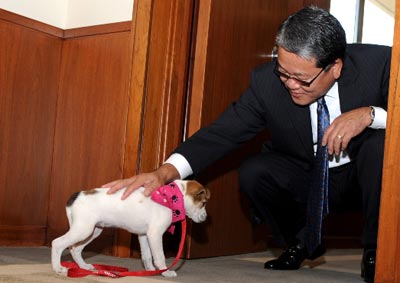Giving new meaning to pet projects in government
November 3, 2009
The leggy young thing seemed a bit nervous, even though she looked great—impeccably groomed, hot pink bandana around her neck. She was accompanied by a couple of handlers to stage-manage every step of her debut performance.
She shook ever so slightly as she waited for a photographer in the VIP parking lot. Eventually, she managed to nibble a few greens, and then—paging TMZ!—she urinated! In public! Right there on the grass!
“It’s always a new adventure,” says Evelina Villa, Los Angeles County’s puppy wrangler, as she scooped up young Madeline, the eight-week-old shepherd mix, who was the day’s star attraction, and headed into the Hall of Administration.Ordinarily, Villa, 24, tends to administrative responsibilities in the Long Beach headquarters of the Department of Animal Care & Control. But most Tuesdays, she goes to The Show—the Board of Supervisors meeting. There, she hands off the animal to Supervisor Michael D. Antonovich, who says a few words to coax would-be adopters attending the meeting or watching the next night on cable TV. ![]()
But before the big show-and-tell moment, Villa presides over a behind-the-scenes ritual that has become part of the culture of board meeting days, a folksy tradition that seems more Mayberry than metropolis. In all, nearly 650 pets have found homes—hundreds with county employees—since the program was started by Antonovich in 1995.
In fact, Villa starts the search on behalf of each animal at the very top, making the rounds of each supervisor’s 8th floor office. The No. 1 priority is finding a home for a needy pet, whether it’s with a soft-touch chief deputy or John Q. Dog Lover.
So just before 9 a.m. on a recent Tuesday, there was Madeline on the red carpet in Antonovich’s office, where the “shepherd mix’” part of her lineage was being debated. “Looks like a Jack Russell,” someone says, sizing up Madeline’s tan and cream markings—patches over both eyes, white strip down the nose.
As Villa moved among the board offices, sporting her “Travelin’ Tails” tote bag, she kept her spiel going: “Anyone interested in adopting a little puppy today? This is Madeline. She needs a home.”
In Supervisor Gloria Molina’s office, staff assistant Carlos Huezo looked like a soft touch—he’s already gotten one puppy from Villa, a German shepherd-boxer mix named Cougar. But on this day, he passed. “Maybe next time,” he says, adding: “We’ve all adopted here.”
Then it was off to the office of Supervisor Zev Yaroslavsky, where staffers have adopted a number of pets over the years, including Row-Z, a shepherd mix who now lives with chief deputy Alisa Katz.
“What do we have here? Ooh, she’s precious,” coos Regina Marquez, a longtime Third District caseworker who last year adopted Rex, a pug-Pekinese mix.
Next stop: the seventh floor offices of Chief Executive Officer William Fujioka, who bent down and attempted some dog-speak: “Maddy, Maddy, Maddy….Hey, baby….Good girl….”
Somebody offered a Pup-A-Roni snack strip. Then they were off to the 3rd floor, where, at 10:03 a.m., Villa made the handoff to Antonovich. Madeline’s moment in the limelight had begun. And, just as quickly, ended.
“So that was it, 10:05,” Villa said. Villa, who majored in business and theater at Whittier College, finds that her current job requires a bit of both: she handles all the finery of dog presentation—bandanas, collars, tiny T-shirts—and also keeps a spreadsheet on where each animal ends up. So she knows at a glance that a lab mix named Cody, for example, went home with a “relative of BOS.”
She administers a 19-point questionnaire (“Do you have a fenced yard?” “How many hours of the day will this pet spend alone without any supervision?”) to would-be adopters. If there are multiple applicants, Villa stages a drawing, with a co-worker picking the winner. New owners pay adoption fees and spay/neuter charges that range from $30 to $100, depending on the type of pet and the length of time the animal has been in the shelter.
So far, Villa has resisted the temptation to nab one of the prospective adoptees for herself, although she once had a close call with a Shi-Tzu mix named Lady.
On this day, she was accompanied by Daelene Jimenez, an animal control officer from the Baldwin Park shelter, who was learning the ropes. (In addition to showing off the animals, the department wants to showcase the range of occupations it offers at its six shelters, and sometimes sends animal control officers and animal care attendants to the board meetings to present the pets Villa has selected and named.)
For Jimenez, this meant an early wake-up call and responsibility for another crucial part of the Tuesday ritual—giving Madeline a bath. Jimenez also got a crash course in the tricks of the trade, meant to avoid any dogs-gone-wild moments involving elected officials. Rule No. 1: Always start the day with a potty break on the Temple Street lawn.
Soon, some older animals will be getting their star turns, as well.
“The puppies we have no problem adopting; we’re hoping to give exposure to some of the beautiful older pets,” says Villa’s boss, Michelle Roaché, deputy director of the department’s Outreach and Special Enforcement Division. (Cats are sometimes featured, too, but don’t ask Villa to wrangle them. She’s allergic.)
It is a point of pride that “100% of the animals featured, including dogs, cats, rabbits, birds, and a guinea pig have been placed in new homes,” says Antonovich spokesman Tony Bell.
As for Madeline, no county employees stepped up to adopt her during Villa’s rounds. “Usually, if we do have takers, I would know by now,” Villa says before heading back to her office. So if no one from the public steps up either, then Madeline would head to a rescue organization, which would continue the hunt. “Our goal is to get the dogs out of the shelter,” Villa says, “It’ll end up good for her.”
In the 12 months ending July 1, 25,246 of the 45,356 dogs impounded into county shelters found homes—nearly 56%. Those who’d like to adopt can check out the department’s website.




















 405 bridge work causes a stink
405 bridge work causes a stink
